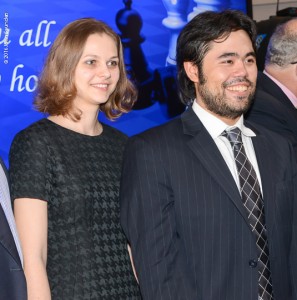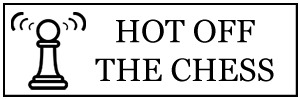
The final day’s play had arrived at the 2016 Tradewise Gibraltar International Chess Tournament. It would begin with the tenth round – the final scheduled round of play. Should it be needed, there would be play off games, and for this reason the action started at an earlier time of 11 in the morning, rather than 3 in the afternoon.
And with eight players leading after round nine, it was likely that play-offs would be needed. And, as round ten unfolded, this was confirmed.
Defending champion, Hikaru Nakamura, put himself in contention, by defeating David Anton Guijjaro. He made rather light work of it also, having the point in 30-moves. Guijjaro chose the Dutch Defence in answer to Nakamura’s 1.d4 and it didn’t really work out for him. He simply just wasn’t able to generate any play, and his pieces became virtual bystanders. Under this circumstance, exchanging down can often alleviate the pressure, but not in this case. White took space and Black became more and more hemmed in. With his position busted, and material starting to fall, Guijjaro’s charge for the title ended, and Nakamura would be certain of at least a play off.
And this he would have, against Maxime Vachier-Lagrave. The Frenchman was up against a countryman of his, Sebastien Maze, who you will remember had defeated Li Chao with Black in the previous round. What could he do with White in this one?
Well, the game was pretty balanced for the most part, with the usual ebbs and flows that we see in a chess game. However, the crux came at move 37. (Diagram.)
Here, there is great tension in the position, and tension is what chess is all about. If one does not have all the ‘i’s dotted and ‘t’s crossed, then one will likely lose. As you can see, there is tension between the dark-squared bishops, and there is also a kind of tension towards the White rooks, which to be honest I really don’t like the look of all hemmed in there on the a-file. Not only this, but there is a targeting of the e1-square by both Black’s rook and Queen. Even though one could say that it is Black with the threats, the position is fairly even here. However, White has some things to consider and getting something wrong could be catastrophic.
The game continued: 37.Kh2 (a very prudent move, take the King out of the line of fire) …Re1 38.Ra4? (this indicates that White is going all in, but it is flawed. 38.Bxe1 Qxe1 39.Nf2 Qe5+ 40.g3 Bxa3 41.Rxa3 sees things hard for either player to progress. John Saunders also gives 38.Nb2 Bxf2 39.Qxf2 as being fine.) …Bxa4 39.Rxa4 Bxf2 (White was either not banking on this move, or had totally miscalculated, Black has the superior resources now.) 40.Rxb4 Bg1+ 41.Kg3 axb4 42.Qd2 (White has only two pieces with which to resist the Black initiative, and neither of them are particularly well placed.) …Re8 43.Qxb4? (This is misguided, (though it is hard to do, White’s best option was probably to wait around with a constructive move such as Kf4, and put the onus on his opponent to prove his advantage and make progress), and Black demonstrates why.) …Rb6.
Here, White resigned, and this may look rather pessimistic, but it is a very valid, insightful decision. In capturing on b4, White has infact helped his opponent to attack his backward pawn. Not only will that fall, but the White King is exposed and will be at Black’s mercy.
And so, after 10 rounds of play, defending champion, Hikaru Nakamura, would fight to keep his title, head-to-head, against Maxime Vachier-Lagrave. The tie-break took the form of two rapid play games, which were both drawn, and then two blitz games, which were also both drawn. This meant that the dreaded ‘Armageddon’ game was brought out to decide the issue once and for all. White would have six minutes to Black’s five, but White would have to win.
Hikaru Nakamura had the luck of the draw on his side on this occasion, and drew the black pieces, which meant that it was Maxime Vachier-Lagrave who had the obligation of pushing for the win. This he duly did, but ended up over-cooking things and lost. This meant that Hikaru Nakamura retained his title, (though in rather less convincing style than he had won last year), and took the £20,000 winnings. Maxime Vachier-Lagrave would be a bit disappointed to be edged out in another tie-break, (he had lost to Magnus Carlsen at the London Chess Classic just weeks back), but with £16,000 going in to the bank as runner up, it’s still not a bad time in the office for him.
Anna Muzychuk won herself £15,000 as the top placed women’s player. Anna had played some superb chess during the tournament, and defeated the likes of Laurent Fressinet on her way to her 7/10 score.

That’s it, then, the Tradewise Gibraltar International Chess Tournament is over for another year, and I must say, it’s a bit of a come down. It is fast putting itself right among the top events when it comes to chess, much to the credit of organisers Brian Callaghan and Stuart Conquest. To them and their team, sincere compliments and congratulations. And also, to John Saunders, Alice Mascarenhas, Sophie Triay and the rest of the team at the press office, who have made my job of compiling information effortless, and with their helpful demeanour are an example to many other tournaments.
For now, the Caleta Hotel, on Gibraltar’s famous rock, gives way to Backgammon I believe, but the dates for next year’s tournament are already confirmed: January 23rd to February 2nd 2017 – can’t wait!

